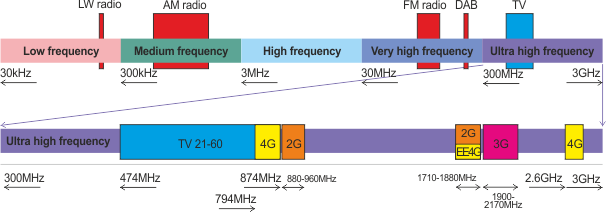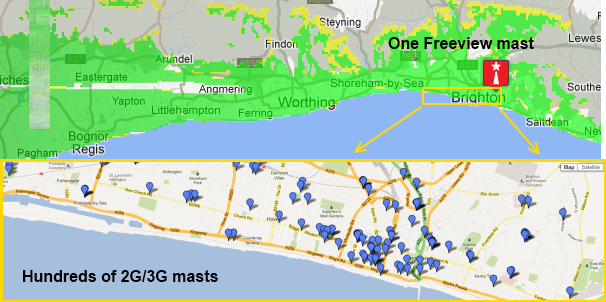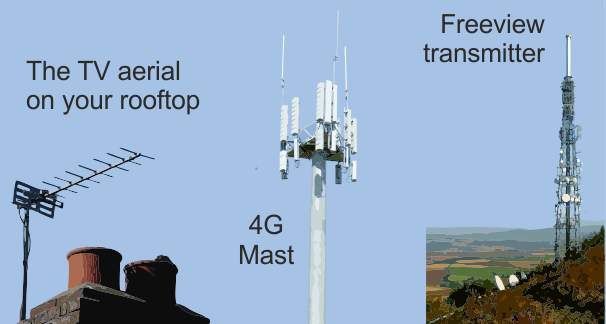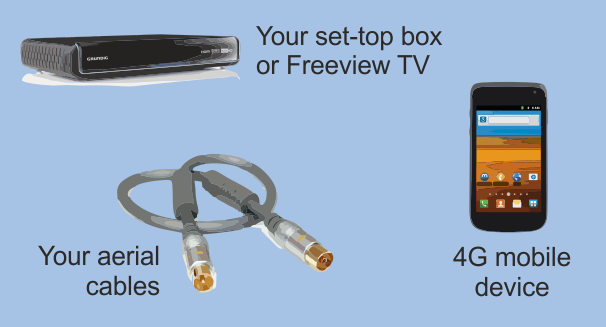How do I know if the 4G broadband will overload my Freeview?
 Brian Butterworth published on UK Free TV
Brian Butterworth published on UK Free TV Back in June 2011, we looked at how Ofcom moves to protect Freeview interference from 4G mobile .
Since then, the television Digital Switchover has been finished and 4th generation (4G) mobile broadband services - also known as Long Term Evoluition (LTE) have launched all over the world, including a service from Everything Everywhere (EE) in the UK.
To understand why and how these 4G broadband services will cause problems during 2013, you need to take into consideration a number of technical factors.
Understanding the radio spectrum
The Radio spectrum is the name given to the frequencies of the electromagnetic spectrum that can be usefully used to transmit radio, television and data services.The top bar on the diagram below (or download) shows a selection of the services used in the UK, with old-fashioned long-wave radio, then medium-wave radio, though FM radio, the digital DAB radio services up to those used for television broadcasting. (See here for a really complex chart).

The highest frequencies on the diagram, the "ultra high frequencies" (or UHF) band is shown enlarged as the lower purple bar. In this range we can see TV "channels C21 to C60" (blue), second- and third- generation mobile phones (2G orange, 3G pink) and the location for the 4G services.
It is important to note that some of the 2G capacity in the "1800MHz" range has already been converted to 4G operation by Everything Everywhere (EE). The other two yellow boxes show the "800MHz" (to the left) "2.6GHz" (on the right).
For the purpose of Freeview reception, only the 800MHz range need be considered. The other two ranges will not cause Freeview problems.
Protecting Freeview receivers against overload
As we have seen already - Freeview signals: too much of a good thing is bad for you - Freeview boxes are designed to protect themselves against signal overloads. When they do this they close down and people often incorrectly diagnose the problem as being "no signal" when there is too much.The problem that has to be solved as the 4G services launch, is that the new mobile broadband signals can cause overloads onto the frequencies that are being used for Freeview.
 One particular problem is that a very common type of Freeview signal decoder, a superheterodyne receivers are sensitive to signals being present nine channels (72MHz) away.
One particular problem is that a very common type of Freeview signal decoder, a superheterodyne receivers are sensitive to signals being present nine channels (72MHz) away.
In addition to overloads, 4G may also cause Signal-Interference Noise Ratio degradation, where reception breaks down because the receiver can no longer decode the digital information in the transmission.
Knowing who will win the 4G auction
 Until the
4G auction takes place, no one will know which company has the right to use the 800MHz channels for mobile devices. The following companies have qualified to bid:
Until the
4G auction takes place, no one will know which company has the right to use the 800MHz channels for mobile devices. The following companies have qualified to bid:
- Everything Everywhere Limited (UK)
- HKT (UK) Company Limited (a subsidiary of PCCW Limited)
- Hutchison 3G UK Limited
- MLL Telecom Ltd
- Niche Spectrum Ventures Limited (a subsidiary of BT Group plc)
- Telefonica UK Limited
- Vodafone Limited
Viewing high power television and using low power mobiles
Using the 'Sitefinder' Mobile Phone Base Station Database you can compare the locations of existing mobile phone "masts" with those used for Freeview Transmitters. Here is an example from Brighton and Hove, where a medium-sized single mast (Whitehawk Hill) can cover a whole city, but where hundreds of mobile phone base-stations cover a many smaller-by-comparison areas.
This illustrates two points. Firstly, that Freeview broadcasts are high powered and one-to-many - mobile devices are low power and peer-to-peer. The mast your TV signal comes from may be miles, sometimes tens or miles away, for your mobile perhaps only meters away.
The second point is that if an existing 2G/3G mobile supplier wins a 800MHz 4G slot, they will wish to use their existing "phone mast" locations (especially the 900MHz ones) as this would be most economical for them. Until the action winners emerge, and then plan their network, only idle speculation about possible interference can be made.
Using the TV frequencies for 4G masts and phones
Research (see here) shows that a 4G mast in relative close proximity, or a mobile 4G handset closer than a meter to an unfiltered Freeview box will cause overloading on many tested devices. The following diagram shows the relationship between the 4G use and the old TV channel designations.
Those Freeview transmitters that use channels above C52 are most likely to have receivers that get overloaded by the use of 4G signals in the 800MHz area. FDD is Frequency-division duplexing - the transmitter and receiver operate at different carrier frequencies.
Interpreting the aerial and mast locations
Once the proposed mast locations for 4G services are known, it will then be possible to predict which homes will need to fit the special filters in areas where Freeview uses the higher channel numbers (the C52 to C60 range).
If you then have a rooftop aerial without a signal amplifier, to get an overload you will need the 4G mast to be in the line-of-sight between your Freeview transmitter and the aerial, or possibly "directly behind" the aerial.
If you then have a rooftop aerial and an amplifier, or perhaps have lower-grade cables, you are likely to need to protect from a 4G overload if the phone mast is close to your rooftop aerial.
Finding transmitters that use the higher range frequencies
Some powerful transmitters and many relays use the high frequencies: Sudbury, Oxford, Belmont, Winter Hill, Tacolneston, Pontop Pike, Mendip, Emley Moor, Clermont Carn, Truskmore and Maghera.Click below to find out the transmitters in with high frequency allocations:
- C60 is used by 126 transmitters - including Sudbury, Oxford, Belmont;
- C59 is used by 142 transmitters - including Winter Hill and Tacolneston;
- C58 is used by 100 transmitters - including Winter Hill, Sudbury, Pontop Pike and Mendip;
- C57 is used by 131 transmitters - including Clermont Carn, Truskmore, Oxford;
- C56 is used by 73 transmitters - including Mendip, Sudbury;
- C55 is used by 139 transmitters - including Maghera, Winter Hill and Tacolneston ;
- C54 is used by 104 transmitters - including Mendip, Pontop Pike and Winter Hill;
- C53 is used by 131 transmitters- including Truskmore, Belmont, Oxford;
- C52 is used by 81 transmitters - including Emley Moor, Sandy Heath, Clermont Carn and Mendip.
Protecting Freeview boxes and sets, cables, amplifiers from 4G devices
Again in areas where Freeview uses the higher channel numbers (C52 and above) you may have to protect your Freeview devices from signals from a 4G handset (such as mobile phone, tablet, or USB "dongle").
This may, once again, require the fitting of a special filter, or the upgrading of the "fly leads" used to connect your aerial to the set top box or TV. This may be a particular problem if you have used an indoor aerial or signal amplifier.
Help with TV/radio stations?
In this section
Monday, 1 December 2014
brian fisher: Yes, if you need one. See Contact us | Advice or general enquiries | at800 for the numbers to call.
| link to this comment |
Sunday, 14 December 2014
S
Stephen Loader8:40 PM
I have a good signal strength but I have problems receiving all channels and some of my TV's in my house work better with out an aerial. The problem started a couple of months ago when we replaced the external aerial. So wondered if 4g could be the problem.
I live in Hartshill Stoke on trent
| link to this comment |
Friday, 6 March 2015
C
Colman8:34 PM
our TV reception is breaking up since a new mast was installed recently in our area this week in Downpatrick, Northern Ireland who we contact to get a filter box for our standard ariell
| link to this comment |
M
MikeB8:39 PM
Colman: Firstly, we need a postcode, becuase we have no idea where you are in relation to the 'new mast'. Secondly, if you were close enough for a mast to give you a problem with 4G, then its likely you were sent a filter through the post from A800 anyway. You can ring them, and they will send you one free, but just becuase you thing 4G is the culprit, its doesn't mean it is - in fact the bulk of supposed 4G problems reported on this site have been nothing of the kind.
Check your signal strength, and which transmitter your tuned into, and then make sure that your aerial system is working properly.
| link to this comment |
Friday, 17 April 2015
R
Rob4:35 PM
I had 4 G masts upgraded allover reading made UHF anolouge signals for my old tv collection rendered 61 to 68 useless unless i put on signal reducer that sorts it out but leave all tv pictures snowy.... cannot do anything about it... will a 4 g filter be worth trying?
thanks for your time
| link to this comment |
J
jb388:36 PM
Rob: Not quite sure about exactly what you are meaning, but though "if" you are referring to a 4G transmitter affecting the analogue output from a Sky boxes modulator? then a 4G filter fitted in line with the Sky boxes aerial input socket should (in theory) rectify the problem.
Its also advisable to set the modulators output on a lower channel number, of course ensuring that it doesn't clash with any of the Mux channels used by the station you receive Freeview from.
| link to this comment |
Thursday, 30 April 2015
T
Thomas kelly7:45 PM
Colman: I suspect 4g is the culprit , my freeview started to breakup and the chanels from soar view disappeared completely , I contacted at800 they sent me a filter , but said I shouldn't be affected as I wasn't close enough to to 4 g transmitter , I live near Saul , and only in last week I am receiving 4g on my mobile ,,,,,,, That's when the problems with signal appeared . after putting on filter everything is perfect , soar view and all
| link to this comment |
Monday, 11 May 2015
Severe disruption to signal in Congleton CW12 starting especially 23rd April 2015. at800tv fitted 2 filters two weeks later, weaking my signal strength. Still disruption, especially C5 and ITV
| link to this comment |
Friday, 12 June 2015
C
Colin Legg9:58 AM
I am having problems watching Netflix. Could this be down to G4 in my area?
| link to this comment |
M
MikeB10:49 AM
Colin Legg: netflix is an internet service, and has nothing to do with TV broadcasts at all. In fact you could well be watching it via 4G. If Netflix is buffering, thats probably due to your broadband speed.
| link to this comment |
Select more comments
Your comment please!